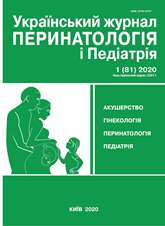Duchenne muscular dystrophy: problems of differential diagnosis and treatment
DOI:
https://doi.org/10.15574/PP.2020.81.106Keywords:
Duchenne muscular dystrophy, dystrophin, Govers symptome, ataluren, orphan diseasesAbstract
The article presents a review of current literature data relating to Duchenne muscular dystrophy associated with DMD gene mutations. One of the early symptoms of DMD is an increased level of transaminases, which leads to the referral of patients to gastroenterologist. Therefore, it is important to determine the creatinkinase blood level in all boys with an unknown increased blood level of transaminases.The purpose of this article is to improve the awareness of a wide range of specialists about Duchenne muscular dystrophy — a disease that requires early diagnosis and treatment.
Based on analysis of various literature sources, modern views on etiology, pathogenesis, clinical-diagnostically characteristic and therapeutic approaches to Duchenne muscular dystrophy were generalized and systematically examined.
No conflict of interest were declared by the authors.
References
Yevtushenko S, Shaimurzin M, Yevtushenko O, Yevtushenko I. (2014). Neuromuscular diseases in children. Donetsk: Knowledge: 218.
Kasatkina LF, Gilvanova ОV. (2010). Electromyographic research methods in the diagnosis of neuromuscular diseases. Needle electromyography Moskov: 416.
Birnkrant D, Bushby K, Bann C et al. (2018). Diagnosis and management of Duchenne muscular dystrophy, part 1: diagnosis, and neuromuscular, rehabilitation, endocrine, and gastrointestinal and nutritional management. Lancet Neurol. 17 (3): 251—267. https://doi.org/10.1016/S1474-4422(18)30024-3.
Birnkrant D, Bushby K, Bann C et al. (2018). Diagnosis and management of Duchenne muscular dystrophy, part 2: Respiratory, cardiac, bone health, and orthopaedic management. Lancet Neurol. 17 (4): 347—361. https://doi.org/10.1016/S1474-4422(18)30025-5.
Birnkrant D, Bushby K, Bann C et al. (2018). Diagnosis and management of Duchenne muscular dystrophy, part 3: primary care, emergency management, psychosocial care, and transitions of care across the lifes-pan. Lancet Neurol. February. doi: 10.1016/ S1474-4422(18)30026-7.
Bloetzer C. (2012). Therapeutictrials for Duchenne muscular dystrophy: between hopes and disappointments. Rev Med Suisse. 8 (329): 409—412.
Bushby K, Finkel R et al. (2014). Ataluren treatment of patients with nonsense mutation dystrophinopathy. Muscle Nerve. 50 (4): 477—487. https://doi.org/10.1002/mus.24332; PMid:25042182 PMCid:PMC4241581
Crone M, Mah J. (2018, Jun 23). Current and Emerging Therapies for Duchenne Muscular Dystrophy. Curr Treat Options Neurol. 20 (8): 31. https://doi.org/10.1007/s11940-018-0513-6; PMid:29936551.
Echevarria L, Aupy P, Goyenvalle A. (2018). Exon-skipping advances for Duchenne muscular dystrophy. Hum Mol Genet. 27: 163—172. https://doi.org/10.1093/hmg/ddy171; PMid:29771317.
Falzarano M.S. et al. (2015). Duchenne: FromDiagnosistoTherapy. Molecules, 20 (10): 18168—18184. https://doi.org/10.3390/molecules201018168; PMid:26457695 PMCid:PMC6332113
Goto M, Komaki H, Takeshita E et al. (2016). Long-term outcomes of steroid therapy for Duchenne muscular dystrophy in Japan. Brain Dev. 38 (9): 785—791. https://doi.org/10.1016/j.braindev.2016.04.001; PMid:27112384
Haas J, Katus H, Meder B. (2011). Next-generation sequencing entering the clinical arena. Mol Cell Probes. 25 (5—6): 206—211. https://doi.org/10.1016/j.mcp.2011.08.005; PMid:21914469.
Josef Zamecnik. (2018). Pathophysiology and the role of muscle biopsy in vacuolar myopathies: hunting for hidden clues. Proc. the 4 EAN Congress Lisbon (Portugal). URL: www.musclegenetable.fr.
Jumah MA, Muhaizea MA et al. (2019). Current management of Duchenne muscular dystrophy in the Middle East: expert report. Neurodegener Dis Manag. 9 (3): 123—133. https://doi.org/10.2217/nmt-2019-0002; PMid:31166138 PMCid:PMC6609894.
Lee T, Takeshima Y et al. (2014). Differences in carrier frequency between mothers of Duchenne and Becker muscular dystrophy patients. J Hum Genet. 59: 46—50. https://doi.org/10.1038/jhg.2013.119; PMid:24225992 PMCid:PMC3970902.
Lim K, Maruyama R et al. (2017). Eteplirsen in the treatment of Duchenne muscular dystrophy. Drug Des Devel Ther. 11: 533—545. https://doi.org/10.2147/DDDT.S97635; PMid:28280301 PMCid:PMC5338848.
Mah J. (2016). Current and emerging treatment strategies for Duchenne muscular dystrophy. Neuropsychiatr Dis Treat. 12 (3): 1795—1807. https://doi.org/10.2147/NDT.S93873; PMid:27524897 PMCid:PMC4966503
Mosqueira M, Zeiger U et al. (2013). Cardiac and Respiratory Dysfunction in Duchenne Muscular Dystrophy and the Role of Second Messengers. Medicinal Research Reviews. 33 (5): 1174—1213. https://doi.org/10.1002/med.21279; PMid:23633235
Muntoni F, Tejura B et al. (2019). A Phase 1b Trial to Assess the Pharmacokinetics of Ezutromid in Pediatric Duchenne Muscular Dystrophy Patients on a Balanced Diet. Clinical Pharmacology in Drug Development. 8 (7): 922—933. https://doi.org/10.1002/cpdd.642; PMid:30650257
Nowak KJ, Davies KE. (2004). Duchenne muscular dystrophy and dystrophin: pathogenesis and opportunities for treatment. EMBO Rep. 5 (9): 872—876. https://doi.org/10.1038/sj.embor.7400221; PMid:15470384 PMCid:PMC1299132.
Polavarapu K. (2016). Muscle MRI in Duchenne muscular dystrophy: Evidence of a distinctive pattern. Neuromuscul Disord. 26 (11): 768—774. https://doi.org/10.1016/j.nmd.2016.09.002; PMid:27666775. Epub 2016 Sep 5.
Ryder S, Leadley RM et al. (2017). The burden, epidemiology, costs and treatment for Duchenne muscular dystrophy: an evidence review. Orphanet J Rare Dis. 12 (1): 79. https://doi.org/10.1186/s13023-017-0631-3; PMid:28446219 PMCid:PMC5405509.
Srivastava G, Srivastava P. (2018). Application of Multiplex PCR for Detection of Duchunne Muscular Dystrophy: A Childhood Neurpmuscular Disorder. J Neurol Neurosci. 9: 262. https://doi.org/10.21767/2171-6625.1000262.
Venugopal V, Pavlakis S. (2019, Jan). Duchenne Muscular Dystrophy. In: StatPearls (Internet). Treasure Island (FL): StatPearls Publishing. URL: https://www.ncbi.nlm.nih.gov/books/NBK482346/ Updated 2019 Nov 15.
Yang X. (2012). Stem cell transplantation for treating Duchenne muscular dystrophy: A Web of Science-based literature analysis. Neural Regen Res. 7 (22): 1744—1751. doi: 10.3969/j.issn.1673-5374.2012.22.010.
Yang YM, Yan K, Liu B et al. (2019). Comprehensive genetic diagnosis of patients with Duchenne/Becker muscular dystrophy (DMD/BMD) and pathogenicity analysis of splice site variants in the DMD gene. J Zhejiang Univ Sci B. 20 (9): 753—765. https://doi.org/10.1631/jzus.B1800541; PMid:31379145 PMCid:PMC6700351.
Downloads
Issue
Section
License
The policy of the Journal “Ukrainian Journal of Perinatology and Pediatrics” is compatible with the vast majority of funders' of open access and self-archiving policies. The journal provides immediate open access route being convinced that everyone – not only scientists - can benefit from research results, and publishes articles exclusively under open access distribution, with a Creative Commons Attribution-Noncommercial 4.0 international license(СС BY-NC).
Authors transfer the copyright to the Journal “MODERN PEDIATRICS. UKRAINE” when the manuscript is accepted for publication. Authors declare that this manuscript has not been published nor is under simultaneous consideration for publication elsewhere. After publication, the articles become freely available on-line to the public.
Readers have the right to use, distribute, and reproduce articles in any medium, provided the articles and the journal are properly cited.
The use of published materials for commercial purposes is strongly prohibited.

